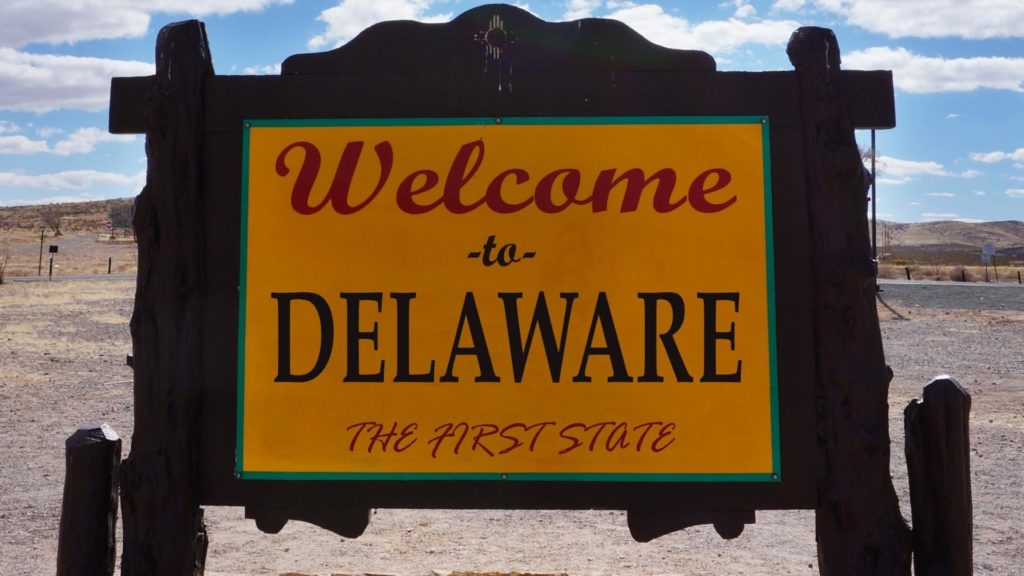
Living or visiting Delaware and wondering what bird you’re looking at? This article covers the most common birds of Delaware. Odds are high the bird you’re looking at is one of them. It will also inform you on how to identify them.
Birding in Delaware
The State of Delaware has two of the most important wildlife sanctuaries for birds in the eastern part of the United States, Prime Hook and Bombay Hook, both located on the shores of Delaware Bay. Here, tens of thousands of waterfowl and shorebirds come to migrate each year, as they do at the Cape Henlopen State Park peninsula, as well. The peninsula has a hawk watch every September 1 through 30.
There are several very popular state parks in Delaware for birders. Cape Henlopen State Park sits at the base of the Delaware Bay and encompasses more than six miles of coastline. From fall through the spring, the park is a home for waterfowl such as loons, Northern Gannet, Great Cormorant, and others.
Dune Road to Herring Point offers great birding opportunities. During the winter months, Purple Sandpipers may be spotted there. There are hawk watches in the fall near the dunes. Birders come to see Black Vultures, Northern Harriers, several types of hawks, American Kestrels, and Peregrine Falcon. Lucky birders may catch a glimpse of the Brown-headed Nuthatch.
Prime Hook National Wildlife Refuge is a 10,000-acre refuge located north of Cape Henlopen. There are bird trails – even a canoe trail – by the visitor center that lead through grassland, marsh, and woodland. The visitor center offers good information about where to explore for birds, mostly along Highway 1 and along Broadkill Road.
Here, Osprey and Bald Eagle reside year-round. Some shorebirds are here all year, as well. The Red Knot and American Oystercatcher can be spotted during the summer months.
Bombay Hook National Wildlife Refuge is a 16,000-acre birding sanctuary on Delaware Bay. The march and ponds attract geese, ducks, shorebirds, and wading birds. The Parson Point Trail is known for its warblers and passerines during spring and fall.
Little Creek Wildlife Area is located south of Bombay Hook National Wildlife Refuge and also attracts an abundance of birds. The area by Port Mahon Road has reported 250 species of shorebirds. Birders can follow the road down to the shore for gulls, terns, and Red Knots. There is an observation tower south of Port Mahon Road at the visitor’s complex.
There are 10 miles of hiking trails in Middle Run Natural Area, where nesting species can frequently be found. The landscape is diverse, and swallows, herons, raptors, woodpeckers, wrens, and several species of orioles and woodpeckers among others can be found here.
The official Delaware Birding Trail consists of 27 official birding sights and is considered the premier birding trail in Delaware.
Most Common Birds of Delaware
Carolina Chickadee
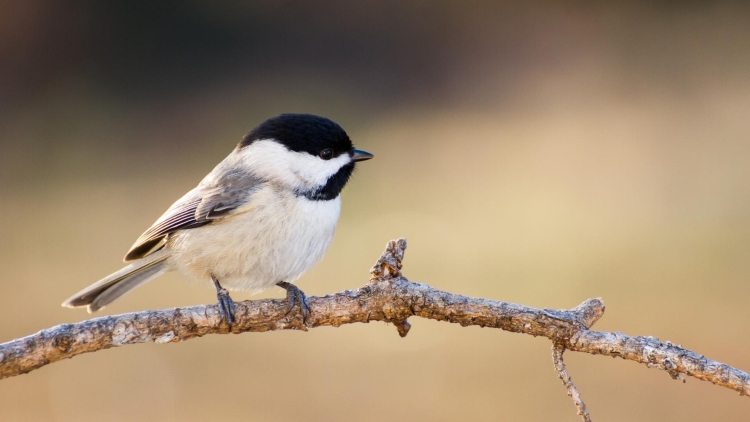
The Carolina Chickadee is the only Chickadee to be found in Delaware, usually in deciduous woodlands and swampy areas, although they also inhabit parks and backyards. This Chickadee is a tiny, plump bird with a large head and a long and narrow tail.
They are mostly shades of soft gray with a black cap and bib and fat, white cheeks. The Carolina Chickadee grows from 3.9 to 4.7 inches in length and weighs 0.3 to 0.4 ounces with a wingspan between 5.l9 to 7.9.
They feed on insects, even wasps and bees, and acorn seeds.
Tufted Titmouse
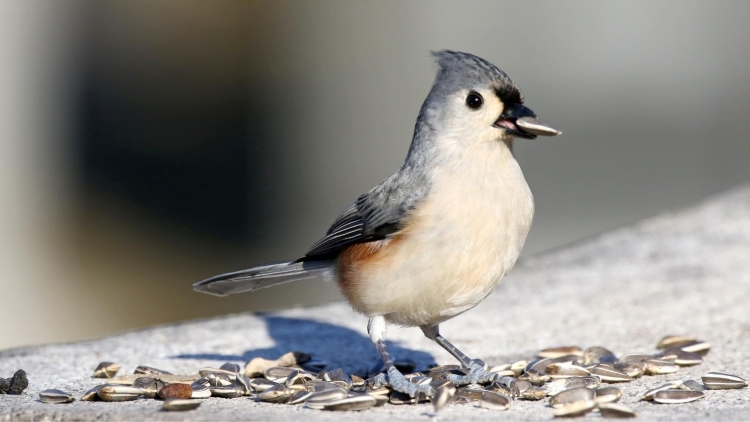
The Tufted Titmouse lives in Delaware all year round. Both sexes have a white underbelly and upper body of varying shades of gray with light, rusty shading on their upper body. The jaunty tuft on the top of the head gives them a “bed-hair” look. They grow between 5.6 and 6.2 inches in length, weigh 0.6 to 1 ounce, with a wingspan between 7.9 to 10.2 inches.
They live in coniferous forests and deciduous woodlands and feed on berries, insects, seeds, and fruits.
European Starling
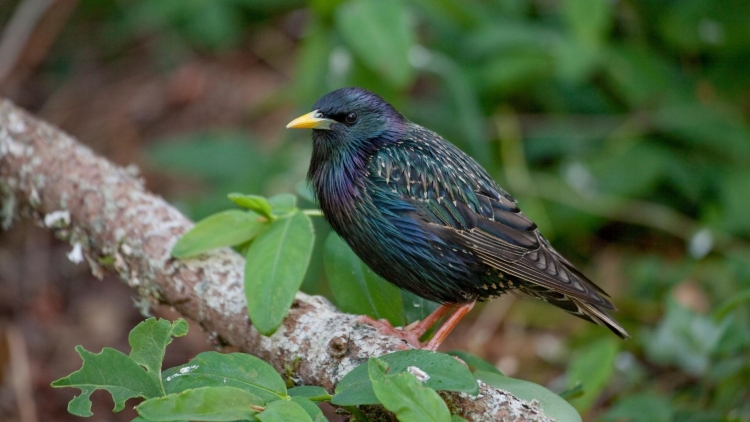
The European Starling, a year-round resident of Delaware, is one of the few birds that has a seasonal wardrobe. During the summer, they are a shimmery purple-green with yellow beaks. In the winter, their plumage is brown and covered in white spots, with a chunky body and a short tail and wings. They grow between 7.9 to 9.1 inches in length, weigh between 2.1 and 3.4 ounces, with a wingspan between 12.2 and 15.8 inches.
They are loud, sociable, and prefer being in large groups of blackbirds, either in towns, suburbs, or near human habitats as they happily feed on almost everything. They can be found perched high on trees and buildings. They are native Europeans – hence the name – and were introduced to the U.S. in 1890 by a man determined to introduce all birds in Shakespearean plays to America. We have Henry IV, Act 1, to thank for the Starling.
When crowd-loving, loud, Starlings gather at a bird feeder, they are likely to deter other birds from visiting.
Black-necked Stilt
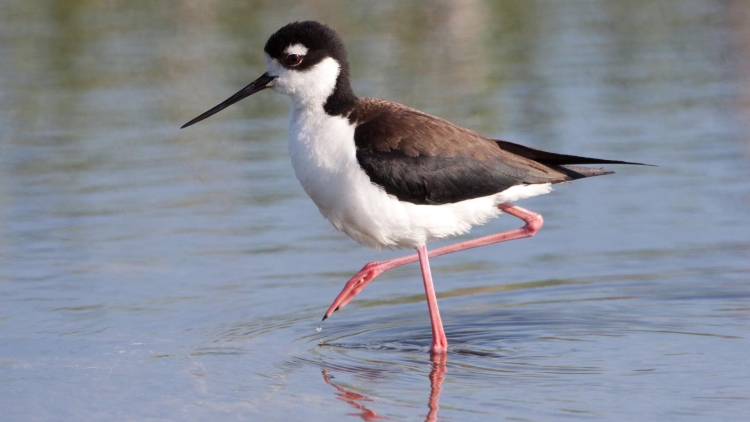
The Black-necked Stilt can be found in coastal regions. In Delaware, they are frequently seen at the Bombay Hook National Wildlife Refuge. They are a tall but small-bodied bird with extremely long, pink legs, a long neck, and a straight, thin bill. Their top and wings are shimmering black. They have a black cap and face with a thick black line in the back of the eyes. Both sexes grow between 13.8 and 15.3 inches in length, weigh between 5.3 and 6.2 ounces, with a wingspan between 28.1 and 29.29.7 inches.
They spend much of their time wading in shallow water in search of invertebrates such as shrimp and crabs.
Eastern Kingbird
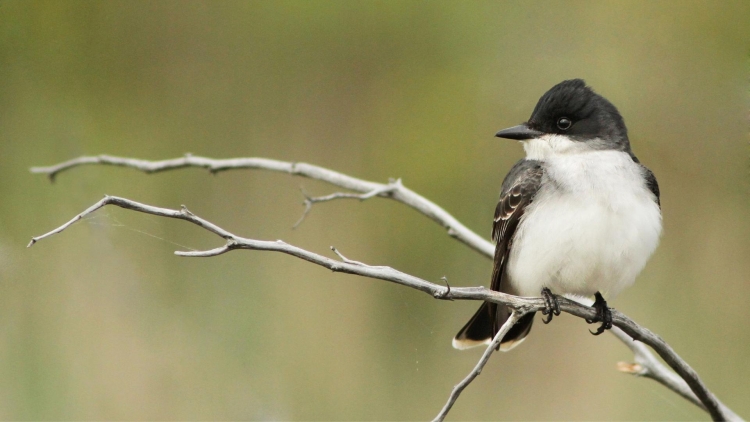
The Eastern Kingbird is a common sight in Delaware and can be frequently spotted at the Bombay Hook. They are sturdy birds with a large head, a square, white-tipped tail, and a short bill. They are black on top, including the head, and white from the throat down the belly. They have red feathers on the crown of their head, but those are usually well-hidden, The Kingbird grows between 7.5 and 9.1 inches in length and weigh 1.2 and 1.9 ounces, with a wingspan between 13.0 and 15.0 inches.
They inhabit yards, fields, grassland, wetland, or forests near water and feed on insects.
Black Birds in Delaware
Black-headed Grosbeak
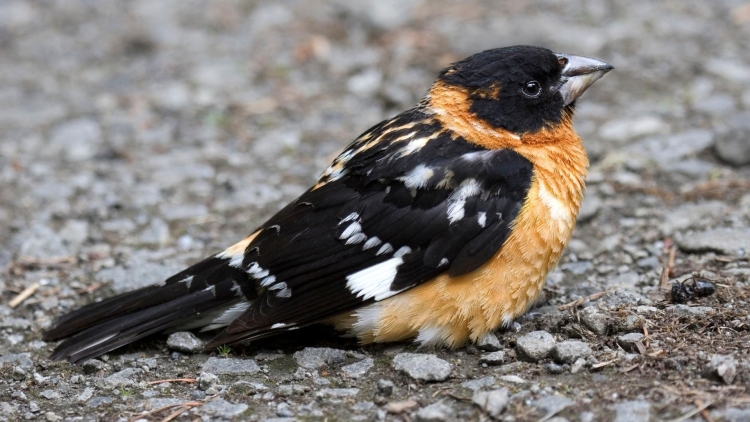
The Black-headed Grosbeak is a flamboyant songbird with a black head and white-barred black wings. The male’s breast is a vibrant cinnamon shade. The female is less cinnamon and more pale lemon. They flash a shade of yellow beneath the wings when they fly. This Grosbeak grows 7.1 to 7.5 inches in length and weighs 1.2 to 1.7 ounces, with a wingspan of 12.6 inches.
They inhabit woodlands, backyards, and gardens and are happy to feed on sunflower seeds as well as insects and berries. It is easy to attract them into a yard with sunflower seeds. Despite the male’s flamboyancy, he is an equal caretaker, nester, and feeder of the young.
Yellow-headed Blackbird
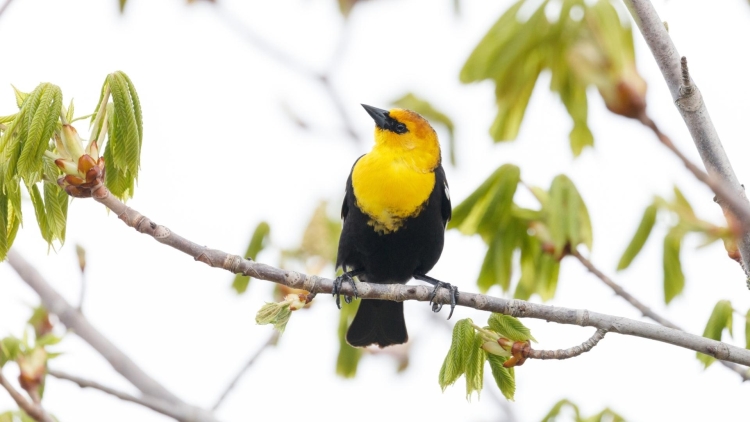
Yellow-headed Blackbird is a stout bird with a large head. The male has a black body with noticeable patches on the wings and a bright yellow head and chest. The female’s head is duller. They grow 8.3 to 10.2 in length and weigh 1.6 to 3.5 ounces, with a wingspan between 16.5 and 17.3 inches.
They inhabit wetlands with dense vegetation and feed on invertebrates and insects.
Common Grackle
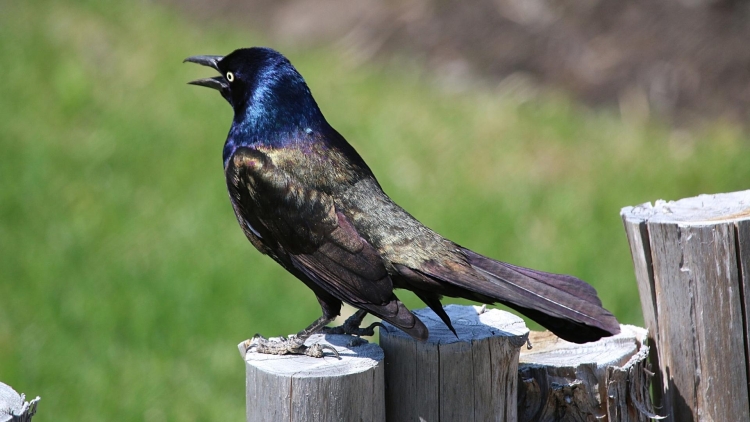
The Common Grackle is a large bird with long legs and a long tail. They are black birds with plenty of blue and green luminescence shining through. The females are less glossy than the male. Both grow 11.0 to 13.4 inches in length and weigh 2.6 to 5.0 ounces with a wingspan between 14.2 and 18.1 inches. These Grackles inhabit fields, meadows, marshes, parks, and open woodland. They especially love to feed on corn kernels.
Blue Birds in Delaware
Blue Jay

Both male and female Blue Jay have a blue crest and blue wings with a white underbelly. There is a blue line across the throat and eyes and black and white bars on the tail and wings. Both sexes grow to 9.8 to 11.8 inches and weigh 2.5 to 3.5 ounces with a wingspan between 13.4 and 16.9 inches. They live on the edge of forests, especially with oak trees, and they also like urban areas. Fruits, acorns, insects, and acorns make up most of their diet. Some of their nuts are left forgotten and grow into oaks on their own.
Indigo Bunting
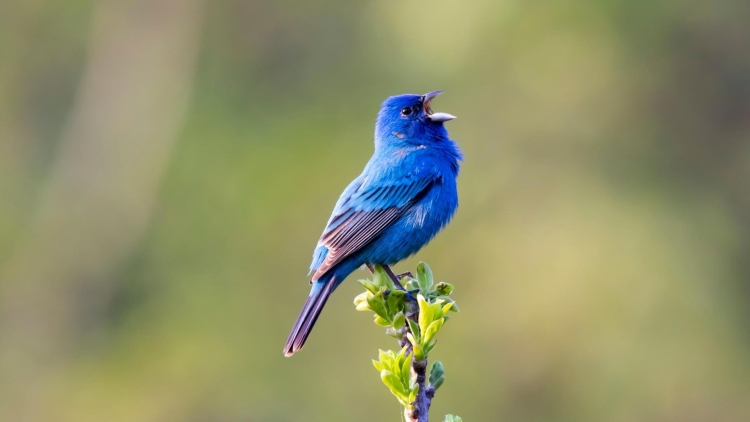
The Indigo Bunting can be found in Delaware year-round. The male is a stunning blue with striping on the wings and a conical bill. The female is brown with only a few hints of blue. They grow 4.7 to 5.0 inches in length and weigh 0.4 to 0.6 ounces with a wingspan between 7.5 to 7.5 to 8.7.
They inhabit dense forests and feed on insects from leaves, seeds, and berries.
Eastern Bluebird

The Eastern Bluebird can be spotted throughout Delaware, especially in Lums Pond State Park. This bluebird is small with a large round head. It has long wings with a short tail and legs.
The wings are long, but the tail and legs are short. The males are a deep blue on top with a rust-colored throat and breast and a white underbelly. The contract is stunning and makes the male look as if he were making a colorful fashion statement. The female is grayer above with a duller orange breast. They grow 6.3 to 8.3 inches in length and weigh 1.0 to 1.1 ounces with a wingspan between 9.8 to 12.6.
They live in open areas, such as meadows with suitable trees for nesting. The Eastern Bluebird feeds on insects and berries. To attract them to a bird feeder, invite them with berries, mealworms, and peanut butter.
Red Birds in Delaware
House Finch

The House Finch resides in Delaware all year long. They are round, with short wings and a long tail. Adult males have a rose-colored face and chest with a rose and white streaked underside. The red color attracts females, who want offspring as red as possible. The female is a streaked brown all over without any red. They grow between 5.1 to 5.5 inches and weigh 0.6 to 0.9 ounces, with a wingspan between 7.9 and 9.8 inches.
They inhabit parks, urban areas, farms, and forest edges, where they use their conical beaks to eat seeds. Sunflower seeds in a bird feeder will bring them to a backyard.
Summer Tanager
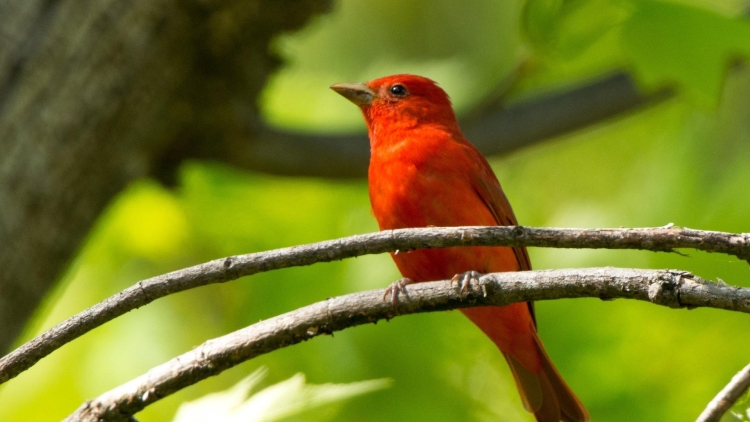
The Summer Tanager is the only completely undiluted, pure red bird in the U.S and can be seen in Delaware between May and October. While it strongly resembles its close relative, the Scarlet Tanager, Scarlet has glossy black wings. The female Summer Tanager has no tinge of red and is a yellowish brown, instead. They grow to 6.7 in length and weigh 1.0 ounce, with a wingspan between 28 and 30 inches.
They like being at the top of a forest canopy of pine or deciduous forest, where they snap up insects in mid-air. Sometimes, they will move down to parks and orchards.
Purple Finch
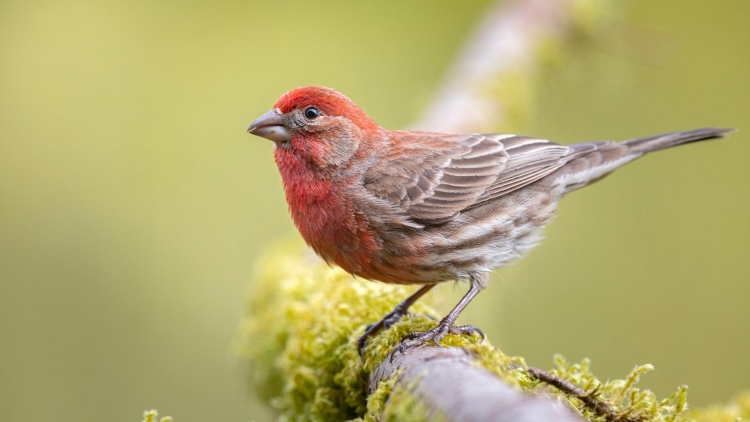
The Purple Finch spends the months of September through June in Delaware. The male has a blush-red head and breast, with some brown on the back and a white underside. As is the case with most red birds, the female has no red whatsoever – she has brown and white streaks throughout with a white stripe by the eyes. Both have strong conical beaks. They grow 4.7 to 6.3 inches in length and weigh 0.6 to 1.1 ounces, with a wingspan between 8.7 and 10.2 inches.
They live high up in coniferous forests and forage there for food. During the winter, they may descend for some seeds.
Orange Birds in Delaware
American Robin

The American Robin lives throughout Delaware and can specifically be spotted at the Bombay Hook National Refuge. It is a grayish bird with a dark head and an orange belly and white below the belly and the tail. The female is a duller shade of orange. They grow to 7.9 to 11.0 inches in length and weigh 2.7 to 3.0 ounces, with a wingspan between 12.2 and 15.8 inches.
They can be found in parks, fields, woodlands, coniferous forests, and golf courses and feed on worms and insects. They will not eat seeds.
Baltimore Oriole
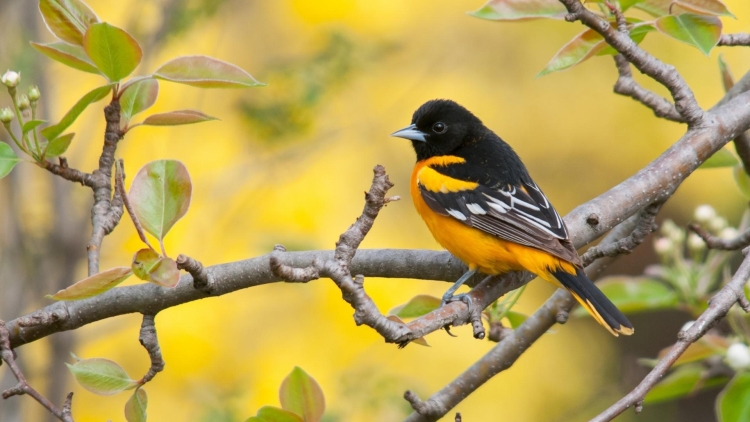
The Baltimore Oriole is a medium-sized bird with long legs and a long, pointed bill. The male has a glowing orange chest, belly, and tail with a black head and a white bar across the wings. The female is duller and has a gray head and two white wing bars. They grow 6.7 to 7.5 inches in length, and weigh 1.1 to 1.4 ounces, with a wingspan between 9.1 and 11.8 inches.
The Baltimore Oriole lives high up in a forest canopy and picks through the leaves for insects and fruit. Sometimes, they descend and feed on fruits from bushes. Fruits and berries will attract them to a backyard feeder.
American Redstart
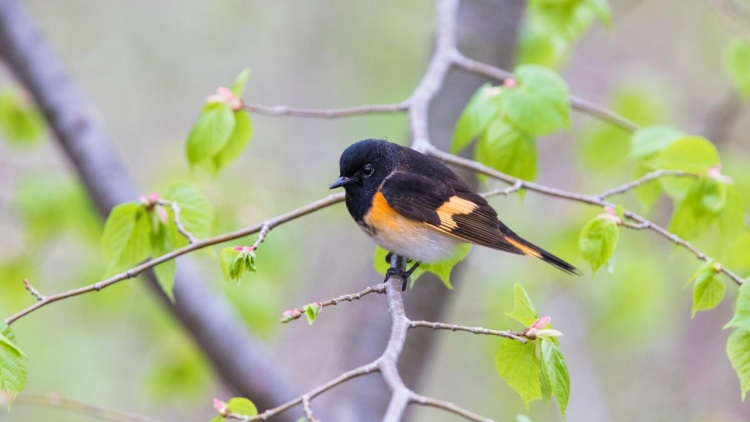
The American Redstart can be spotted easily in Bombay Hook. Males are black with bright orange on the sides, tails, and wings. These wings can be spread to a gorgeous display of bright orange in motion and is a major factor in the courtship routine. The female is gray with yellow hues. They grow between 4.3 to 5.5 in length and weigh from 0.25 to .30 ounces, with a wingspan between 6.3 to 9.1 inches.
They like to inhabit deciduous trees and snap insects out of the air.
Yellow Birds in Delaware
American Goldfinch

The American Goldfinch can be spotted year-round in Delaware but more often during the summer. The males are a vivid yellow with a black forehead and wings. There are white markings on the wings and by the tail. The female is a duller olive color. Both become drabber during the winter, with more brown than black. They grow between 4.3 to 5.1 inches in length and weigh 0.4 to 0.7 ounces, with a wingspan between 7.5 to 8.7.
They inhabit fields, and floodplains with thistles and asters, as well as orchards and backyards, and feed on seeds. They do not eat insects.
Common Yellowthroat
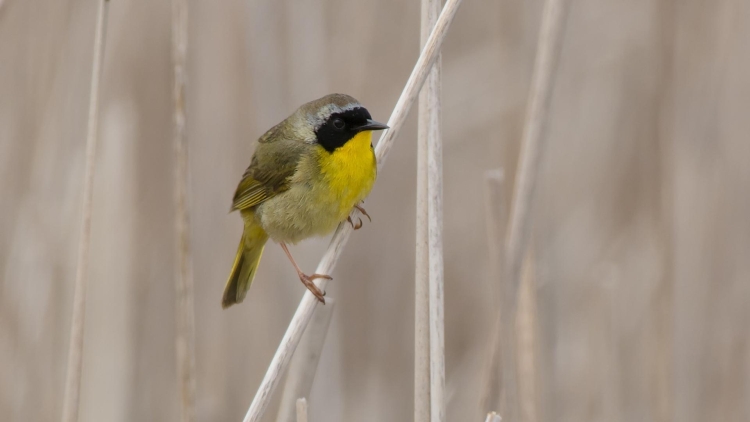
The Common Yellowthroat can be found throughout Delaware, including Bombay Hook. They are small and chunky, with a round head. Adult males have a yellow throat, with a black, mask-like face and tanned wings and underbelly. Females are more olive with some hint of yellow at the throat and beneath the tail. They do not have the black mask.
They grow to a length of 4.3 to 5.1 inches and weigh 0.3 ounces, with a wingspan between 5.9 to 7.5 inches. They inhabit pine forests, marshland, and grassland, and their diet consists mainly of insects, but they will also eat a few seeds.
Yellow-throated Vireo
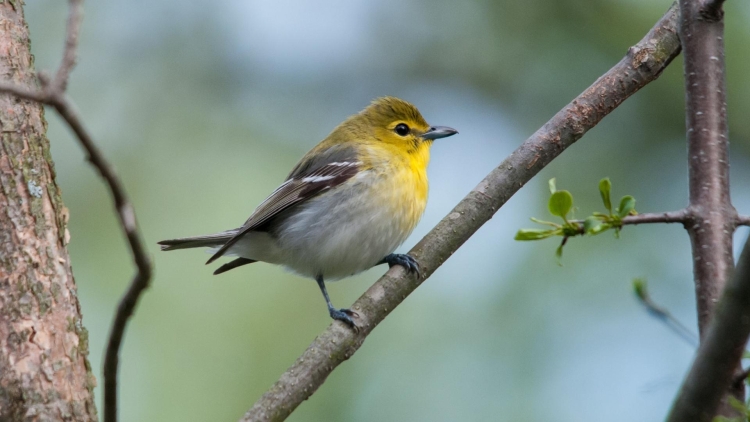
The Yellow-throated Vireo can be found in Delaware during the breeding season. They are chunky with a short tail and thick bill. The male has an olive head and chest with gray and white striped wings and a white underbelly. Both the male and the female look as if they are wearing bright yellow eyeglasses. They grow between 5.1 and 5.9 inches in length and weigh 0.5 to 0.7 ounces, with a wingspan of 9.1 inches.
They live in deciduous forests and feed off the insects on the leaves and branches. They search for the occasional berry, as well.
Common Birds of Delaware by Species
Warblers in Delaware
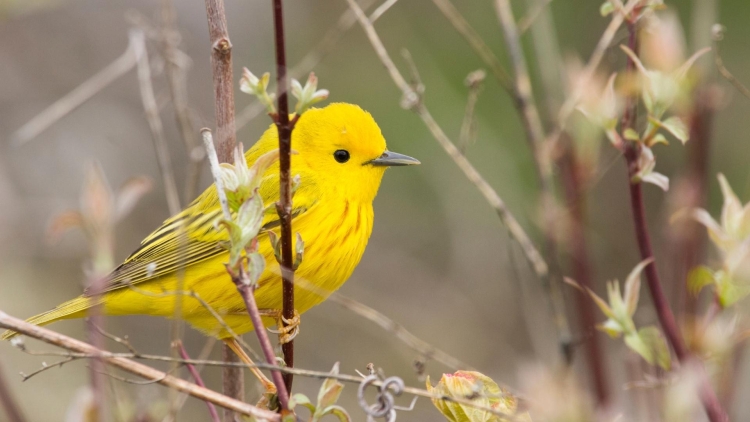
The Yellow Warbler – Setophaga petechia – can be spotted in Delaware from April through October. They are bright yellow with an olive back. The male has brown and yellow streaks on his wings while the female has duller colors and does not have any streaks. They grow between 4.7 and 5.1 inches in length and weigh 0.3 to 0.4 ounces, with a wingspan between 6.3 and 7.9 inches. They inhabit wetlands and forage for insects.
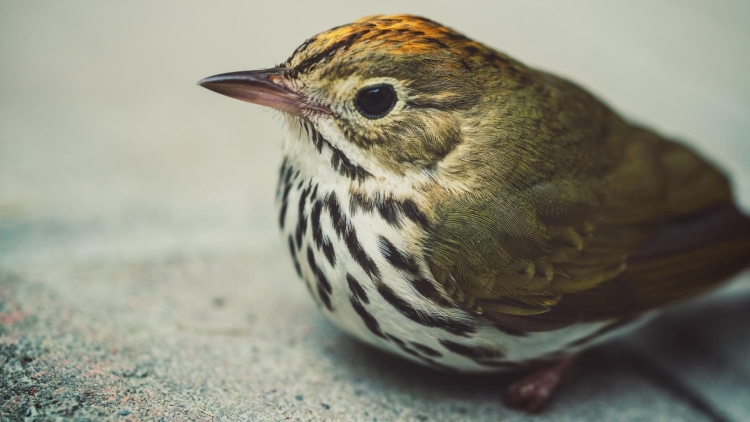
Ovenbird – Seiurus aurocapilla – can be seen in Delaware from April through October. This warbler is not a beauty contest winner, but his voice is magnificent. He is a dull olive-brown with dark streaks covering a white breast. They grow 4.3 to 5.5 inches in length and weigh 0.6 to 1.0 ounces, with a wingspan between 7.5 to 10.2 inches. Their head is topped by a black and orange strip, the one sign of actual color. The Ovenbird lives in deciduous forests and feeds on insects.
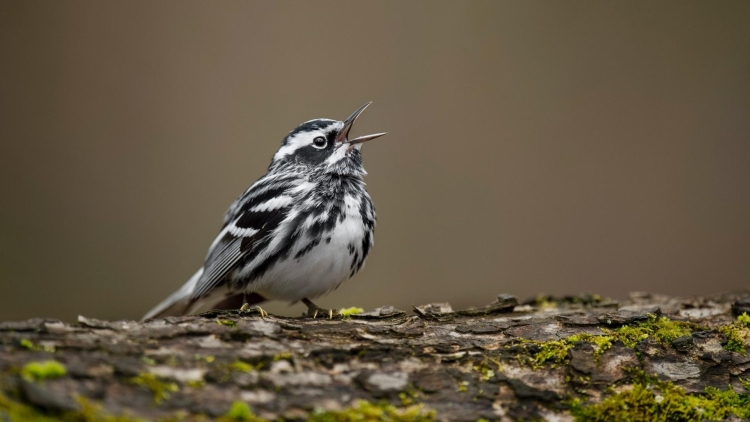
Black and White Warbler – Mniotilta varia – is the most stunning warbler in Delaware. They are streaked black and white, with two white bars across the wings – formally dressed and someplace to go. Both sexes have white eyebrows and a black streak by the eyes. They grow 4.3 to 5.1 inches in length and weigh 0.3 to 0.5 ounces, with a wingspan between 7.1 and 8.7 inches. Look for this warbler in deciduous and coniferous trees, where they search for insects hiding in the bark.
Herons in Delaware

Great Blue Heron – Ardea Herodias – can be spotted around Delaware Bay. This is a large heron with long legs, a graceful neck, a stripe down its face, and a daggerlike bill with wing feathers that are an almost see-through blue. They grow between 38.1 to 53.9 inches and weigh 74.1 to 88.2 ounces, with a wingspan between 65.8 to 79.1 inches.
They stalk their prey – usually fish, but not always – in shallow water or field and catch their quarry with that ferociously strong bill. It lives either near salt or freshwater areas, riverbanks, or lakes and is easily recognized during flights as it trails its legs straight back and curls its neck into an “S.”
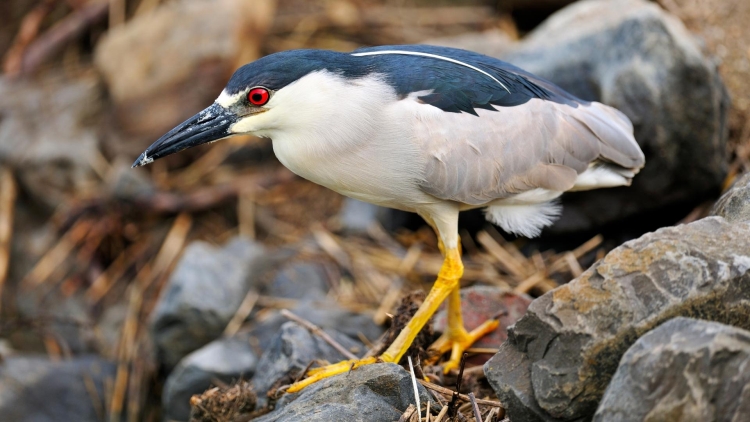
Black Crowned Night Heron – Nycticorax nycticorax – is the most common heron in Delaware, but it is difficult to spot. True to its name, it comes out mostly at night, avoiding competition for food. Short, stocky, and almost devoid of a neck, it is the antithesis of its Blue Heron relative. They have short legs and large heads, and are light gray with a black back, crown, and bill; the underbelly is white.
They grow to 22.8 to 26.0 inches in length, and weigh between 25.6 and 35.8 ounces, with a wingspan between 25.6 to 35.8 inches. They live near marshes and lakes but spend the day concealed in trees. They come out at night for fish, crustaceans, snakes, clams, and rodents.
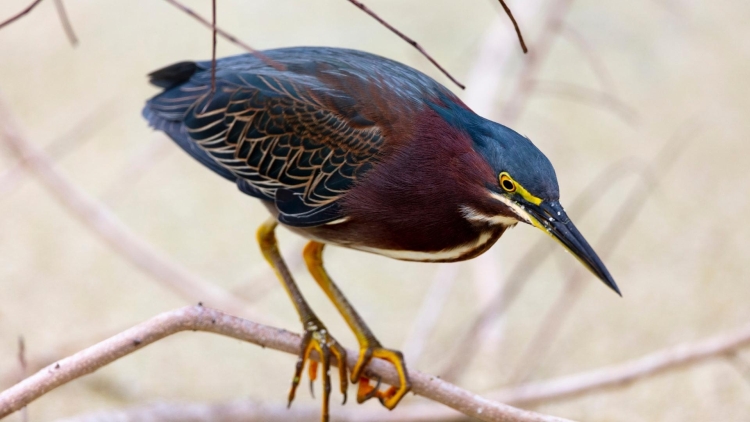
Green Heron – Butorides virescens – is a small heron that can be found spring through autumn in the marshes and wetlands of Chesapeake Bay. They look dark from afar, but they are actually a luminescent blue-green with a brown breast and neck and a blue-green cap. The wings are dark gray, and the legs are yellow. They grow to a length of 16.1 to 18.1 inches and weigh 8.5 ounces, with a wingspan between 25.2 to 26.8 inches. They inhabit marshes, ponds, and rivers and use their bills to catch fish.
Shorebirds in Delaware
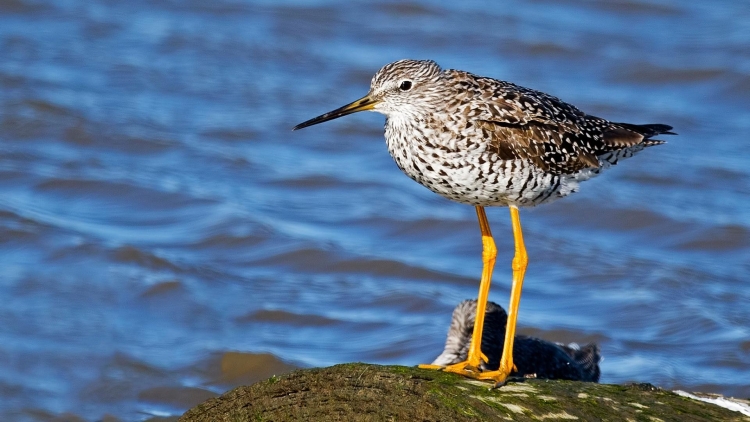
Greater Yellowlegs – Ringa melanoleuca – lives along the Delaware shoreline and is seen at the Prime Hook and Dike Trail. It has a speckled brown and white back with a white belly. Its most noticeable features are its bright, yellow legs and long, thin bill. Both sexes grow to 11.4 to 13.0 in length and weigh 4.5 to 7.7 ounces, with a wingspan of 23.6. They inhabit mudflats and marshes, where they feed mostly on fish, crab eggs, crustaceans, tadpoles, worms, and insects.
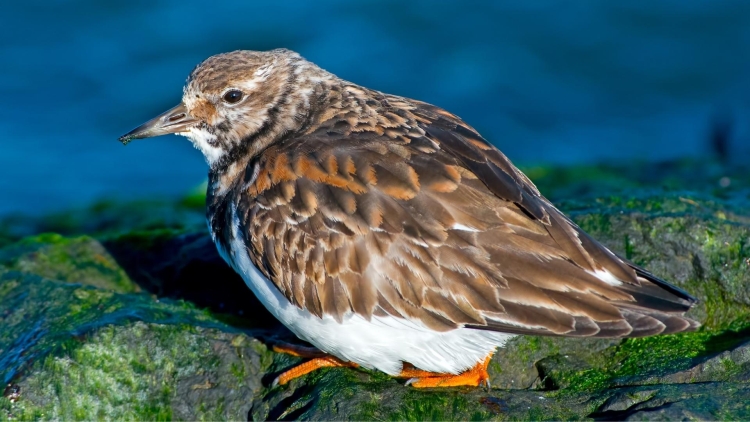
Ruddy Turnstone – Arenaria interpres – can be found on the Delaware Bay beaches during their migration beginning in May. Breeding males have a distinct chestnut and black pattern on the back, a black throat, and orange legs. The breeding female is a paler version of her mate. Both sexes grow 6.3 to 8.3 inches in length and weigh 3.0 to 6.7 ounces, with a wingspan between 19.7 to 22.4 inches. The mainstay of their diet are flies, but they also eat spiders, bees, wasps, crustaceans, and bird eggs.

American Oystercatcher – Haematopus palliates – has been returning to Delaware Bay regularly. Their back wings are brown, and their head and breast are black, with a white belly, yellow eyes, and red eyes. Their foremost feature is the long, orange bill they use to catch the oysters and other mollusks, which make up most of their diet. They inhabit beaches and nearby areas. The American Oystercatcher grows between 15 to 19 inches in length with a wingspan between 28.5 and 36 inches.
Further Reading on Delaware Birding
For more information on birding in Delaware, consider the following guidebooks:
- Tekiela, Stan (Author)
- English (Publication Language)
- Parnell, Marc (Author)
- English (Publication Language)
Visit these websites for additional information:


